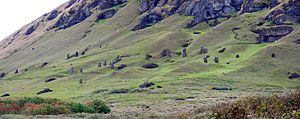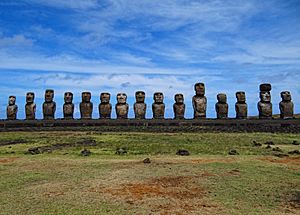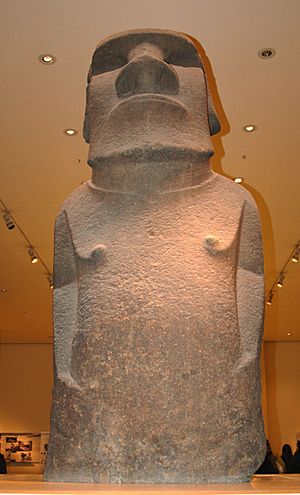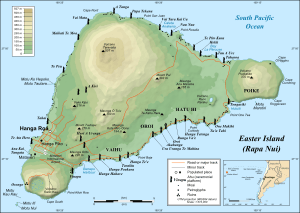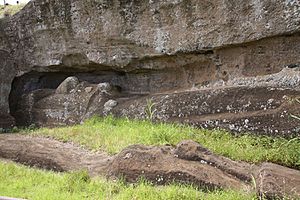Moai facts for kids
Moai are huge stone statues found on Easter Island, a small island in the Pacific Ocean. Each moai is carved from a single large stone. Some even have an extra stone piece on top of their heads, like a hat. Most of these statues were made from volcanic rock found in the Rano Raraku area of the island.
People sometimes call them "Easter Island heads." But moai actually have shoulders, arms, and bodies too! Their heads are just very big compared to their bodies. Also, many famous moai were buried up to their shoulders over time, making only their heads visible. Most moai are between 2.5 and 10 metres tall. They usually weigh around 14 tonnes. There are about 1000 moai spread around the island's coast. Nearly 400 more unfinished statues were left at Rano Raraku.
It's still a mystery exactly when, why, and how these giant statues were made. Experts believe they were created almost 1000 years ago. The Polynesian people who lived there likely made them. They wanted to honor their ancestors, who were older family members who had passed away. The moai were also believed to bring good luck.
Making these statues took a lot of time and hard work. To move them, people might have used wooden sledges or rollers. They might have even "walked" them by rocking the moai along. The newest moai found was built around 1350. Around that time, the island faced cold weather, little food, and wars. By the 19th century, all the moai had been pushed over. Today, some have been carefully put back up.
Contents
What Moai Look Like
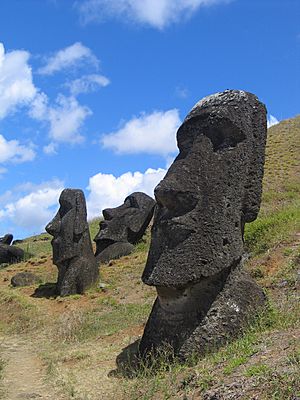
Moai are huge statues carved from one piece of stone. Their style is simple, similar to other art found in Polynesia. The faces of the moai look proud but also mysterious. Carvers first outlined the human shape on the rock wall. Then they chipped away the stone until only the statue remained.
The heads are very large compared to the bodies. This shows how important the head was in Polynesian beliefs. Moai have heavy eyebrows and long noses with a special fish-hook shape at the nostrils. Their lips stick out in a thin pout. Like the nose, their ears are long and oval. The jawlines stand out against their short necks.
Their bodies are heavy. Sometimes, you can see faint outlines of collarbones. The arms are carved in a flat style, called bas relief. They rest against the body in different ways. Hands and long, thin fingers often rest along the hips. The thumbs sometimes point towards the belly button. Usually, the backs of the statues are not very detailed. But some have ring or belt designs on their lower backs. Except for one kneeling moai, the statues do not have clear legs.
Even though moai are full-body statues, they are often mistakenly called "Easter Island heads." This is partly because their heads are so big. Also, many famous pictures show moai on the slopes of Rano Raraku that are buried up to their shoulders. Some of these "heads" have been dug up. Their bodies were then seen to have markings that were protected from weather by being buried.
Most moai are about 4 meters (13 feet) tall. Their bases are usually around 1.6 meters (5.2 feet) wide. These massive statues typically weigh about 12.5 tonnes (13.8 tons) each.
Almost all of the more than 900 known moai were carved from tuff. Tuff is a soft rock made from compressed volcanic ash. It came from Rano Raraku. There are still 394 moai there in different stages of being made. A few moai were carved from other types of rock. These include 13 from basalt, 22 from trachyte, and 17 from fragile red scoria. After carving, the builders would rub the statue with pumice to smooth it.
Special Features
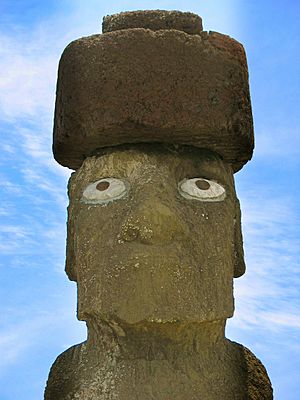
Easter Island statues are known for their large, wide noses and strong chins. They also have rectangle-shaped ears and deep eye slits. Their bodies are usually in a squatting position. Their arms rest in different ways, and they do not have legs. Most moai are found along the coast. They face inland towards the villages, as if watching over the people. However, some moai, like those at Ahu Akivi, face out to sea. This might have been to help sailors find the island.
Moai Eyes
In 1979, a team of archaeologists made an exciting discovery. They found that the moai's eye sockets were made to hold special eyes. These eyes were made of white coral with pupils of black obsidian or red scoria. They found broken pieces of white coral at different sites and put them back together. This showed how the eyes looked.
It is thought that moai with carved eye sockets were placed at important ceremonial sites. This suggests that the design of the moai was very important to the Rapa Nui people.
What Moai Mean
Many experts believe that the moai statues were symbols of power and authority. This included both religious and political power. But they were more than just symbols. The people who built them believed the statues held a sacred spirit. In ancient Polynesian religions, carved objects were thought to be filled with a magical spiritual energy called mana.
Archaeologists think the statues represented the ancient Polynesians' ancestors. The moai statues face away from the ocean and towards the villages. This is like they are watching over the people. The only exception is the seven moai at Ahu Akivi. They face out to sea, possibly to help travelers find the island. There is a legend that says these seven moai waited for their king to arrive.
Pukao Topknots
Some of the newer moai have pukao on their heads. These look like large, round topknots or hats. They represent the topknot hairstyles of important chiefs. Local traditions say that a person's mana, or spiritual power, was kept in their hair. The pukao were carved from red scoria. This is a very light rock from a quarry called Puna Pau. The color red is considered sacred in Polynesia. Adding pukao to a moai showed even more importance.
Carvings on Moai
When moai were first carved, their surfaces were polished smooth. This was done by rubbing them with pumice stone. However, the soft rock most moai were made from wears away easily. Today, the best way to see the original details is on the few moai made from harder basalt rock. We can also see them in old photos or archaeological records of buried moai.
Moai that are less worn down often have designs carved on their backs and bottoms. In 1914, an expedition led by Katherine Routledge found a link between these designs and the island's traditional tattoos. These tattoos had been stopped by missionaries about 50 years earlier. This was important proof that the moai were carved by the Rapa Nui people themselves.
At least some of the moai were painted. For example, Hoa Hakananai'a was decorated with maroon and white paint. This was before it was moved from the island in 1868. It is now kept in the British Museum in London.
How Moai Were Made and Moved
The statues were carved by the Polynesian people who settled Easter Island. Most were made between about 1250 A.D. and 1500 A.D. Besides honoring dead ancestors, the moai also showed the power of living or past chiefs. They were important symbols of family status. The bigger the statue, the more mana, or power, the chief who ordered it had. There was a lot of competition among the islanders to build the grandest statue. This is why moai come in so many different sizes.
Once completed, the statues were moved to special platforms called ahu, mostly along the coast. Then they were set upright. Sometimes, red stone cylinders called pukao were placed on their heads. Making and moving moai must have been very expensive and difficult. Not only did carving each statue take a lot of effort and resources, but the finished statue then had to be hauled to its final spot and lifted into place.
The quarries in Rano Raraku seem to have been left suddenly. There are stone tools scattered around. Many finished moai are outside the quarry, waiting to be moved. Almost as many unfinished statues are still in the quarry itself. In the 1800s, some people thought the island was part of a sunken continent. They believed most completed moai were under the sea. That idea has been proven wrong. Now, we understand that:
- Some statues were carvings in the rock and were never meant to be finished.
- Some were left incomplete because carvers found hard spots in the rock. They would then abandon that statue and start a new one.
- Some finished statues at Rano Raraku were placed there permanently, not just waiting to be moved.
- Some were indeed unfinished when the time of statue-building ended.
Who Made Them?
It's not known exactly which groups in the communities were responsible for carving the statues. Old stories suggest that moai were carved by skilled professional carvers. These carvers were as important as high-ranking members of other Polynesian craft groups. Other stories say that members of each family clan carved their own moai. The old stories also show that the Rano Raraku quarry was divided into different areas for each clan.
Images for kids
-
Moai facing inland at Ahu Tongariki, restored by Chilean archaeologist Claudio Cristino in the 1990s
-
Ahu Akivi, the furthest inland of all the ahu
-
Original moai at the Louvre Museum, in Paris
-
Early European drawing of moai, in the lower half of a 1770 Spanish map of Easter Island; the original manuscript maps of the Spanish expedition are in Naval Museum of Madrid and in The Jack Daulton Collection, US.
-
Tukuturi at Rano Raraku is the only kneeling moai and one of the few made of red scoria.
-
Moai on the Easter Island, a painting by William Hodges, 1775–76
See also
 In Spanish: Moái para niños
In Spanish: Moái para niños


